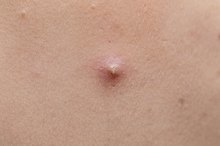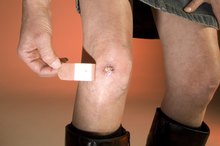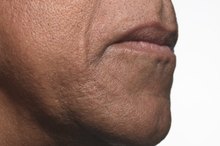How to Get Rid of Acne Scars and Big Pores
You can often treat shallow acne scars with gentle fruit acids, castor oil and silicone gel, while deeper, pitted scars may require a dermatologist’s assistance. Start with all-natural treatments first -- if they reduce the appearance of scars, you won’t need to expose your skin to harsher chemical treatments. If you do decide to pursue a surgical alternative, be sure you take care of your treated skin with daily doses of sunblock and moisturizer.
Nonsurgical Methods
Slough away dark, shallow acne scars with a homemade papaya mask. Use papaya’s natural fruit acid to help fade your skin’s uneven pigmentation, according to Sharon Ronen of Skin Haven Spa, when asked for skin care tips by “Marie Claire” magazine 1. To make the mask, blend 1/2 cup mashed papaya with 2 tablespoons honey. Apply the mixture to your face, leave it on for 20 minutes and then rinse with cool water.
How to Remove a Deep Scar on My Lip
Learn More
Break up any puffy, raised scar tissue with castor oil. Castor oil can penetrate scars and break up their fatty deposits, causing them to shrink, according to Skinverse. Soak a cotton ball in castor oil and place it over your scar for several hours a day; use medical tape to hold the cotton ball in place.
Dot silicone gel over your scars. Silicone can often flatten and fade scars, according to Columbia University’s Health Q&A Service 2. While scientists aren’t sure exactly why this works, they think it has to do with silicone’s natural static electricity and the effect it has on your skin, trapping moisture and lining up existing collagen fibers to give the skin a smoother, plumper appearance.
Embedded Blackheads & Pits
Learn More
Make big pores less noticeable with an over-the-counter topical retinoid cream. According to Dr. Richard Glogau of the University of California at San Francisco, you won’t have much luck “shrinking” pores -- the best you can do is stimulate collagen growth to smooth skin and keep your pores unclogged. He suggests you stick with prescription or drugstore retinoids rather than seeking out clinical treatments like chemical peels that could expose, rather than shrink, your pores.
- Slough away dark, shallow acne scars with a homemade papaya mask.
- He suggests you stick with prescription or drugstore retinoids rather than seeking out clinical treatments like chemical peels that could expose, rather than shrink, your pores.
Surgical Alternatives
Perform microdermabrasion. Dermabrasion removes small impurities like surface wrinkles and light scarring by removing skin’s topmost layers with specialized equipment, revealing the younger looking skin beneath, according to Johns Hopkins.
Ask your dermatologist about laser resurfacing. A cosmetic surgeon uses lasers to smooth away wrinkles and impurities on the outer layer of facial skin.
Get a glycolic acid peel. Glycolic acid removes the rough layer of dead skin cells on the surface of the face, and with monthly treatment can fade uneven pigmentation, according to Johns Hopkins.
- Perform microdermabrasion.
- Dermabrasion removes small impurities like surface wrinkles and light scarring by removing skin’s topmost layers with specialized equipment, revealing the younger looking skin beneath, according to Johns Hopkins.
Related Articles
References
- “Marie Claire” magazine: Homemade Facial Masks
- Columbia University’s Health Q&A Internet Service: Embarrassing scars
- Johns Hopkins Medicine: Plastic and Reconstructive Surgery -- Skin Treatments
- Saint-jean M, Khammari A, Jasson F, Nguyen JM, Dréno B. Different cutaneous innate immunity profiles in acne patients with and without atrophic scars. Eur J Dermatol. 2016;26(1):68-74. doi:10.1684/ejd.2015.2713
- Archer CB, Cohen SN, Baron SE. Guidance on the diagnosis and clinical management of acne. Clin Exp Dermatol. 2012;37 Suppl 1:1-6. doi:10.1111/j.1365-2230.2012.04335.x
- Woolery-lloyd H, Kammer JN. Treatment of hyperpigmentation. Semin Cutan Med Surg. 2011;30(3):171-5. doi:10.1016/j.sder.2011.06.004
- Hedelund L, Haak CS, Togsverd-bo K, Bogh MK, Bjerring P, Haedersdal M. Fractional CO2 laser resurfacing for atrophic acne scars: a randomized controlled trial with blinded response evaluation. Lasers Surg Med. 2012;44(6):447-52. doi:10.1002/lsm.22048
- Hedelund L, Moreau KE, Beyer DM, Nymann P, Haedersdal M. Fractional nonablative 1,540-nm laser resurfacing of atrophic acne scars. A randomized controlled trial with blinded response evaluation. Lasers Med Sci. 2010;25(5):749-54. doi:10.1007/s10103-010-0801-1
- Kim EK, Hovsepian RV, Mathew P, Paul MD. Dermabrasion. Clin Plast Surg. 2011;38(3):391-5, v-vi. doi:10.1016/j.cps.2011.05.001
- Wollina U, Goldman A. Fillers for the improvement in acne scars. Clin Cosmet Investig Dermatol. 2015;8:493-9. doi:10.2147/CCID.S86478
- Fabbrocini G, Annunziata MC, D'arco V, et al. Acne scars: pathogenesis, classification and treatment. Dermatol Res Pract. 2010;2010:893080. doi:10.1155/2010/893080
- Alexiades M. "Laser and Light-Based Treatments of Acne and Acne Scarring." Clinics in Dermatology. 2017 Mar - Apr;35(2):183-189.
- Fife D. "Evaluation of Acne Scars: How to Assess Them and What to Tell the Patient." Dermatologic Clinics. 2016 Apr;34(2):207-13.
- Werschler WP, Few JW, Jacob CI, Joseph JH, Spencer JM, Taub AF. "Advancing the Care of Post-Acne Scarring: Expert Insights Into New Treatment Options." Journal of Drugs in Dermatology. 2016 May 1;15(5):518-25.
- Zaleski-Larsen LA, Fabi SG, McGraw T, Taylor M. "Acne Scar Treatment: A Multimodality Approach Tailored to Scar Type." Dermatologic Surgery. 2016 May;42 Suppl 2:S139-49.
- Zouboulis CC, Bettoli V. "Management of Severe Acne." British Journal of Dermatology. 2015 Jul;172 Suppl 1:27-36.
Writer Bio
Jenni Wiltz's fiction has been published in "The Portland Review," "Sacramento News & Review" and "The Copperfield Review." She has a bachelor's degree in English and history from the University of California, Davis and is working on a master's degree in English at Sacramento State. She has worked as a grant coordinator, senior editor and advertising copywriter and has been a professional writer since 2003.









